Tell Your Ancestor’s Story: Use Social History for Genealogy
Do you wish you knew more about your ancestor’s everyday life experience? Use social history for genealogy: to fill in the gaps between documented events.
Recently we heard from Barbara Starmans, a social historian, genealogist and longtime listener of three of Lisa’s podcasts. She wrote to share a new blog she started.
“While I’ve maintained my Out of My Tree Genealogy blog for many years, I’ve just launched The Social Historian, a longform story website featuring social history themed articles from across the centuries and around the world.”
Social history is about “the lives of ordinary people,” explains Barbara. “It is a view of history from the bottom up, rather than from the top down…. [It’s about] understanding…how people lived, worked and played in their daily lives. It is often the minutia of someone’s life that tells the story of who they were and what they believed in.”
“By exploring social history, you will be able to research all the circumstances of your ancestors’ lives and to build their life stories from the details you find.” Barbara send us a great list that we adapted and boiled down to a few core topics:
- Life cycle: Birth and birthing customs, health and lifestyle practices, medicine, diseases and epidemics, mental health, mortality rates, death and burial customs.
- Life at home: Clothing and fashion, food and cooking, housekeeping, land and property, alcohol and drug use.
- Life at work: Economy (prices, cost of living and salaries), occupations, working conditions and the labor movement, businesses and employers, social welfare and relief.
- Relationships: Morality, marriage and divorce, children and childhood, ethnicity and prejudices,
- Community life: Celebrations and holidays, traditions, education, language and literacy, religion/church, faith, crime and punishment, societal unrest, leisure pursuits.
- Game changers: War, emigration, inventions, transportation, communication, slavery and emancipation.
Barbara’s social history blog gives lots of great examples of her belief that “beyond just names and dates, those who came before us have a story to tell….By learning about their time and place and how they lived in it, you can add to your understanding of who they were.”
Resources

The Genealogist’s Google Toolbox by Lisa Louise Cooke is packed with strategies for learning about your ancestors’ lives online. There’s an entire chapter on using Google Scholar for genealogy!
Where can you look for social history online? I’d start with these sites:
1. Make sure you’re using all of Google’s fantastic resources, including Google Books and Google Scholar
2. Click to find Social history resources at the Library of Congress
3. American Social History Project at the City University of New York
Have fun! I think learning about the everyday lives of our ancestors is one of the most fascinating parts of family history.
Polish Genealogy: 4 Steps to Find Your Family History
Researching your Polish genealogy may seem a little intimidating at the start. Read these get-started tips from a Polish genealogy veteran at Legacy Tree Genealogists. Then you’ll know how to dive right into your Polish family history–and where to turn if you need a little help.

Thanks to Legacy Tree Genealogists for supplying this guest blog post. Legacy Tree employs researchers with a wide range of expertise. They asked their Polish expert, Julie, to share tips for finding Polish ancestors, based on her decades of experience.
If you’re an American researching your Polish ancestors, you aren’t alone. Polish Americans make up the largest Slavic ethnic group in the United States, second largest Central and Eastern European group, and the eighth largest immigrant group overall. So how do you begin tracing your roots in Poland?
Get Started: 4 Polish Genealogy Tips
1. Get to know the basics of Polish history.
Probably every Polish-American family has heard mention of the “border changes” that were supposedly the reason why Grandpa’s papers say he was from Austria, although everyone knew he was Polish. What many people don’t realize is that Poland did not exist as an independent nation from 1795 until 1918. Historically, Polish lands were partitioned among the Russian, Prussian, and Austrian Empires, and ethnic Poles were citizens of one of those three nations. This is why you might see your Polish ancestors stating Russian birth on the 1910 U.S. census, but Polish birth on the 1920 U.S. census, after Poland was reestablished as an independent nation.
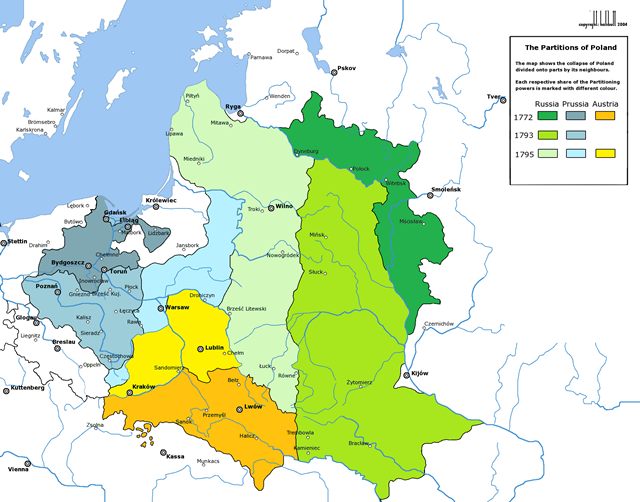
By Rzeczpospolita_Rozbiory_3.png: Halibuttderivative work: Sneecs (talk) – Rzeczpospolita_Rozbiory_3.png, CC BY-SA 3.0, click to view on Wikipedia.
2. Determine your Polish ancestor’s religion.
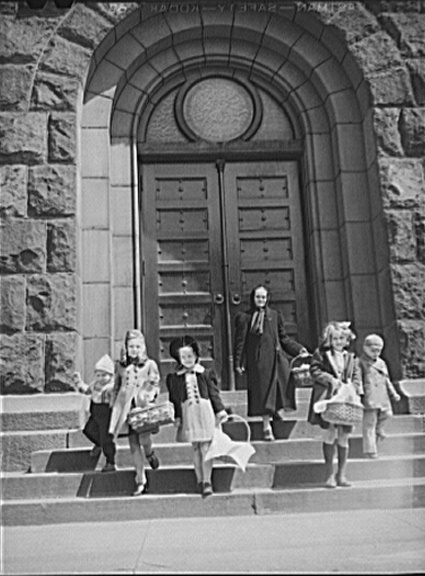
Buffalo, New York. Children of the Polish community leaving church with baskets of food on the day before Easter. Library of Congress photo; digital image via Wikipedia. Click to view.
Although we in the U.S. are accustomed to the separation of church and state, this was not the case in many places. In Poland, it was common for priests, ministers, or rabbis to act as civil registrars, blending ecclesiastical and government authority as they recorded births, marriages, and burials. Although this was the protocol in all three partitions for the majority of the 19th century, the exact span of dates in which this was true vary based on the partition in which your ancestors lived, and greatly affects where you should be searching for the records you need. In “Russian Poland,” for example, civil record keeping began in 1808 with Roman Catholic priests acting as civil registrars for people of all faiths (not just Catholics). Beginning in 1826, each faith was allowed to keep its own civil records using a paragraph-style format that remained relatively stable through the 1930s. Civil registration that was independent of any religious organization did not begin until 1945.
The fact that civil copies of church records were made increases the likelihood that records survived for your ancestor’s town. There’s a persistent myth that “all the records were destroyed in the wars,” but that’s simply not true in most instances. Existing records for some locations date back to the 1600s, but in other places surviving records are sparser.
3. Use U.S. records to determine your ancestor’s precise place of origin.
Grandma may have said that her father came from Warsaw, but most of our ancestors came from small villages, not large cities. It’s more likely that her father was using Warsaw as a point of geographic reference to give people a rough idea of where he lived, since others are unlikely to recognize the name of a small village. This means that you most likely won’t find his birth record by looking for it in Warsaw, but it also leaves you in the dark about where to look instead.
 What kinds of records are most likely to indicate a precise place of birth? Passenger manifests and petitions for naturalization (if dated after 1906) are great sources for this information. If your Polish ancestors were Catholic, church records from the parish they attended in the U.S. are much more likely to contain specific place of birth than their civil equivalents. These include marriage records for immigrants who married in the U.S., baptismal records for U.S.-born children of immigrants, and church death/burial records.
What kinds of records are most likely to indicate a precise place of birth? Passenger manifests and petitions for naturalization (if dated after 1906) are great sources for this information. If your Polish ancestors were Catholic, church records from the parish they attended in the U.S. are much more likely to contain specific place of birth than their civil equivalents. These include marriage records for immigrants who married in the U.S., baptismal records for U.S.-born children of immigrants, and church death/burial records.
Click here for an article about a woman who found her Polish Catholic grandparents’ church marriage record–and with it their overseas birth place–at St. Stanislaus parish in Buffalo, NY. You’ll also learn tips for finding Catholic church records in the U.S.
If your ancestors were Jewish, check cemetery records for mention of any landsmannschaft to which they might have belonged. Landsmannschaften were fraternal aid societies organized by immigrants from the same town in Europe, and they frequently purchased large burial plots for their members.
4. Use a gazetteer to determine the parish or registry office that served your ancestor’s village.
Depending on which partition your ancestors came from, some good gazetteers include:
- The Słownik geograficzny Królestwa Polskiego i innych krajów słowiańskich, or Geographical Dictionary of the Kingdom of Poland and Other Slavic Countries, published between 1880 and 1902 in 15 volumes. The SGKP is written in Polish.
- The Skorowidz Królestwa Polskiego, which includes all of Russian Poland (officially known as the “Królestwo Polskie” or Kingdom of Poland) published in 1877. The SKP is mostly written in Polish with some text in Russian.
- Kartenmeister, an easy-to-use online gazetteer for “German Poland” that covers East Prussia, West Prussia, Brandenburg, Posen, Pomerania, and Silesia. Kartenmeister can be searched using either the German or the Polish name for a town.
- The Galician Town Locator, offered by Gesher Galicia, is another easy-to-use resource that covers the historic Galicia region, which was a part of the Austrian Empire that is now split between Poland and Ukraine.
- The JewishGen Gazetteer is a phonetic gazetteer to assist in identifying the correct location in cases where your ancestor’s place of origin is misspelled on U.S. records. It covers areas throughout Central and Eastern Europe.
Once you have correctly identified both your ancestor’s place of birth and the location of his place of worship or civil records office, you’re ready to make the jump back to records in Poland.
Get Expert Help with Your Polish Genealogy Questions
 We at Legacy Tree Genealogists would be honored to assist you with any step along the way in your journey to discover your ancestral origins, including onsite research if needed. Our experts have the linguistic and research skills to efficiently find your family. Contact us today for a free consultation.
We at Legacy Tree Genealogists would be honored to assist you with any step along the way in your journey to discover your ancestral origins, including onsite research if needed. Our experts have the linguistic and research skills to efficiently find your family. Contact us today for a free consultation.
Exclusive offer for Genealogy Gems readers: Save $100 on a 20-hour research project using code GG100, valid through October 31st, 2017.
German Place Names: Find Your Ancestors’ Hometown with This Free Online Tool
German place names have changed dramatically over time, so it can be challenging to identify your German ancestors’ place of origin. This free online tool helps family historians navigate changes in German place names, jurisdictions, and boundaries. Thank you to...Got Criminal Ancestors? How to Investigate Their Crimes
Lydia thinks her great-grandfather was murdered–perhaps even by her grandfather! Here’s some advice for her and everyone researching “cold cases” for criminal ancestors on your family tree.
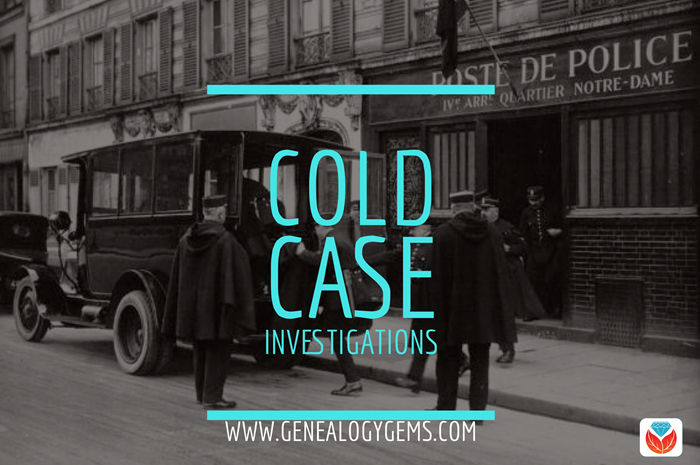
I heard recently from Lydia with these intriguing questions:
My great great grandpa William John Gabriel Nelson disappeared one day, never coming home from work. It was family lore that he had been “shanghai’d.” But even as a child the story didn’t add up. [Through a] few other mentions of the account throughout the years, and recently reconnecting with cousins through Ancestry.com/DNA and your advice to just email DNA matches, I have a growing reason to believe my great-grandfather was murdered. An even bigger fear is that my grandfather may have been the one to do it.All parties involved with this are now dead, so follow-up is impossible with them. But I’m wondering about contacting the Los Angeles Police Department (LAPD) or the library to determine if indeed there was a cold case, missing persons report or John Doe. Since this happened in the mid 1940’s, would I contact the LAPD or is this now a job for a historian?
As a citizen, Lydia can certainly contact the LAPD here. It might take a bit of persistence to get to the right person or resource. I would start by asking for how you can find out the status of a cold case from the year in question.
Here are 4 ways to follow up on your own criminal ancestors’ cold cases:
1. Look for cold case files online.
As I often say, all good searches start online because they will help you prepare to go offline. In other words, not everything is online, but searching online first will give you a lay of the land, revealing what is available, who to contact, and where to go in person. Start with a Google search such as LAPD cold cases. The search results include several good leads:
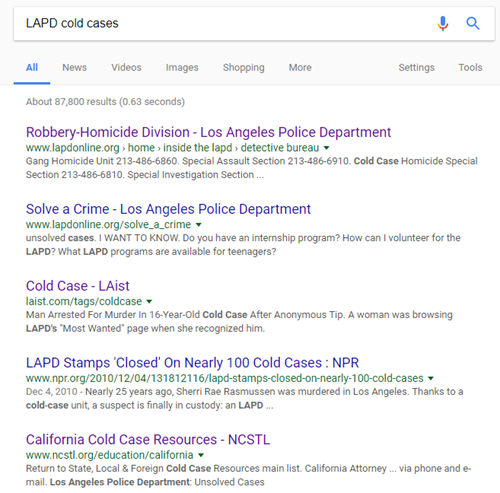
With a case like Lydia’s that is over 70 years old, I wouldn’t expect to pull it up in an online database (though you never know!) But I do see several sites here that provide phone numbers to gain access to those who can lead you in the right direction.
2. Search Google for clues.
 Use Google’s powerful search technology to look for online mentions of the names, places, and dates of your particular case.
Use Google’s powerful search technology to look for online mentions of the names, places, and dates of your particular case.
In Lydia’s case, she might begin with keywords relating to her great-grandfather’s disappearance, with his name, year, and the place he was last seen. Including descriptive keywords such as disappear, mystery, vanished or murder might also yield helpful results.
Learn more about effective search techniques in my book, The Genealogist’s Google Toolbox, Second Edition.
3. Check old newspapers.
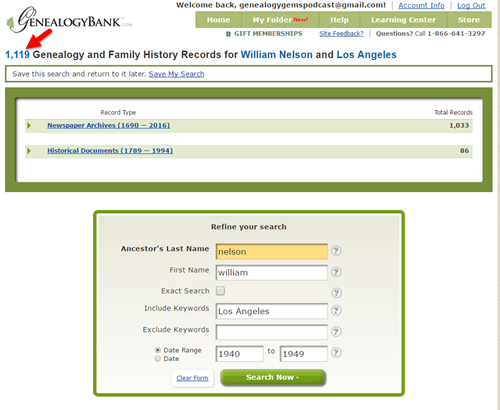
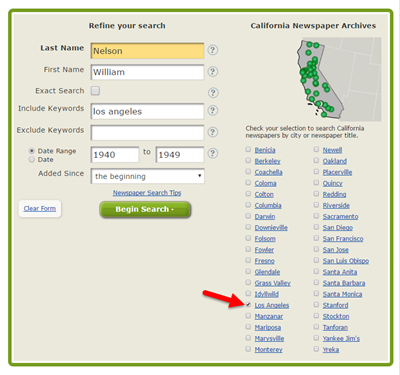
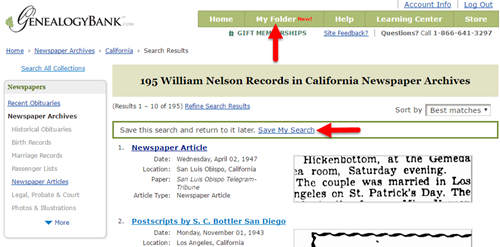
4. Look for criminal records.
 If you knew (or suspected) that a relative was prosecuted for a crime, it’s time to start looking for records relating to the criminal case. There may be several kinds:
If you knew (or suspected) that a relative was prosecuted for a crime, it’s time to start looking for records relating to the criminal case. There may be several kinds:
- In cases of suspicious death (where there was a body, unlike Lydia’s case), look for any surviving coroner’s records.
- If a trial may have occurred, research the jurisdiction to find out what court would have handled it, and then look for files relating to the case.
- If an ancestor may have served time, look for prison records. Genealogy Gems Premium podcast episode 29 is devoted to the topic of prison records.
Get inspired!
Read this article about a woman who was researching not one but two mysterious deaths on her family tree.
Want to help investigators lay to rest their own cold cases?
Click here to read about the Unclaimed Persons Project and how you can help.


